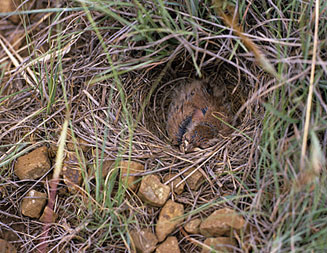|
Certhilauda semitorquata (Eastern Long-billed lark)
Grasveldlangbeklewerik [Afrikaans]; Cotovia-de-bico-comprido do Karoo
[Portuguese]
Life
> Eukaryotes >
Opisthokonta
> Metazoa (animals) >
Bilateria >
Deuterostomia > Chordata >
Craniata > Vertebrata (vertebrates) > Gnathostomata (jawed
vertebrates) > Teleostomi (teleost fish) > Osteichthyes (bony fish) > Class:
Sarcopterygii (lobe-finned
fish) > Stegocephalia (terrestrial
vertebrates) > Tetrapoda
(four-legged vertebrates) > Reptiliomorpha > Amniota >
Reptilia (reptiles) >
Romeriida > Diapsida > Archosauromorpha > Archosauria >
Dinosauria
(dinosaurs) > Saurischia > Theropoda (bipedal predatory dinosaurs) >
Coelurosauria > Maniraptora > Aves
(birds) > Order: Passeriformes
> Family: Alaudidae
> Genus: Certhilauda
Distribution and habitat
Endemic to South Africa and Lesotho, occurring from
Mpumalanga and Gauteng to the North-West Province, KwaZulu-Natal, Lesotho and
the Eastern Cape. It generally prefers grassland, sometimes mixed with shrubland
and especially on rocky ridges.
Food
It mainly eats invertebrates, doing most of its foraging on
the ground, plucking food items from the soil surface and bases of grass tufts. The following food items have been recorded
in its diet:
- Insects
- Solifugids
- Seeds of the shrub Hermannia
Breeding
- The nest (see image below) is a cup built of dry grass built mainly by the
female, with a clump of peddles in front of it. It is typically placed at
the base of a grass tuft or under an overhanging rock in a hollow.
 |
|
|
Eastern long-billed lark nest with chick,
Wakkerstroom, South Africa. [photo
Warwick Tarboton ©] |
|
- It lays 2-3 eggs, usually in the months from September-January, peaking
from October-November.
- Very little is known about the chicks, other than that they are fed by
both parents.
Threats
Not threatened, partly due its preference for grassland on
rocky ridges, which is typically not suitable for agriculture.
References
-
Hockey PAR, Dean WRJ and Ryan PG 2005. Roberts
- Birds of southern Africa, VIIth ed. The Trustees of the John Voelcker
Bird Book Fund, Cape Town.
|
